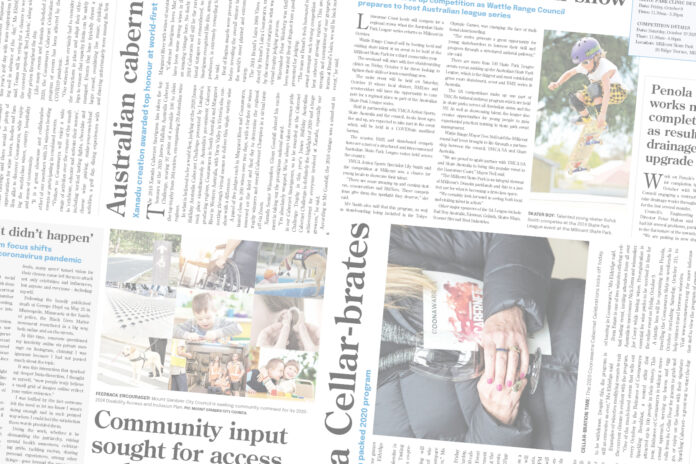An increase in development applications received by Mount Gambier City Council over the past two years has been attributed to the unforeseen impacts of the COVID-19 pandemic.
According to council data, a significant increase in the number of development applications were lodged in 2020 and 2021 when compared with the number of applications lodged in 2018 and 2019.
In 2021, just shy of 700 development applications were lodged and in 2020 a total of 586 applications were received by council.
In comparison, 377 applications were lodged in 2019 and 404 in 2018.
The topic of development applications was raised when City Growth general manager Tim Coote addressed council at its December general meeting.
He said the past year had presented a number of challenges for council.
“It’s been a highly unusual year for a number of different reasons with a lot of pressure being put on planning,” he said.
“This year has been particularly challenging for a number of different reasons. COVID has presented its own stresses, as well as going to a new planning system.”
In March last year PlanSA introduced a new system where lodging, tracking, paying and assessment of all development applications has been centralised to a state system.
Despite the challenges, Mr Coote praised council staff efforts.
“Nothing has run down to the wire and everything has gone through. I’m happy to share information and happy with the team’s efforts and certainly looking forward to strengthening them,” he said.
Mr Coote said council had its own time-frame for building approvals.
“Combined planning and approvals are 19 days on average. About five days for planning and 14 days for approvals. With everything being complete, planning land divisions are going to six days,” he said.
As of March last year, all development applications are now assessed under the new Planning, Development and Infrastructure Act, with the new system affecting how development applications are lodged and assessed. The new ePlanning system has become a one-stop-shop for all planning and design applications.
Council’s Development Services manager Tracy Tzioutziouklaris said the increase in development applications had been caused by a wide range of external influences.
She said this was particularly due to unforeseen impacts of the COVID-19 pandemic.
“Both the Federal and State Government introduced significant grant funding towards the construction of new houses, people are not travelling and are therefore spending their money doing projects around the house such as renovations and building garages, pergolas (and the likes),” she said.
“Council is also receiving numerous enquiries from people living interstate such as Sydney and Melbourne.
“The increase in the flexibility of workplaces in adapting to people working from home and not in the traditional office setting has also perhaps contributed towards an increase in people looking to relocate to regional areas creating a demand for new building work, along with an apparent real estate boom.”
Ms Tzioutziouklaris said the majority of applications submitted last year had been for residential developments including 116 of these for dwellings.
Other residential developments included 109 applications for sheds, 48 carports, 43 verandahs and 23 applications for dwelling additions.
“Other applications have been for a range of developments such as commercial and industrial, tourist accommodation, fences, retaining walls and solar panels,” she said.
“The new Planning, Development and Infrastructure Act 2016 introduced significant changes and the largest reform of South Australia’s planning and development system in over 20 years.”
Though the new system is supported by council, Ms Tzioutziouklaris said it must be recognised the new system was different and complex.
“It has been a process of adjustment and learning for the whole of the development industry which includes council, builders and designers to change and embrace the new system,” she said.
“Overall, the new system is easier to use and is a significant improvement from the old system.
“The new system is evolving regularly to ensure it is user friendly and produces the outcomes it was intended to provide.”
Meanwhile Ms Tzioutziouklaris said vacancies within the development services team had been vacant for a lengthy period of time, adding this was not just an issue specific to Mount Gambier.
“There is generally a shortage of both professional planning and building officers throughout Australia, which council is competing against to attract qualified staff to the region,” she said.
“To help fill existing vacancies council is also willing to support its staff to upskill in areas of interest.
“All existing development staff are required to attend regular training to maintain accreditation and recognition.
“Elected members have indicated an interest in scheduling a workshop with the development and building industry.”
Ms Tzioutziouklaris said this would be to ascertain what issues were currently affecting the industry within the City of Mount Gambier.
During the meeting Councillor Max Bruins raised his concerns about council’s HR resources.
He questioned what actions were being undertaken to address issues of shortage of HR resources in the planning area.
Mr Coote said council was undertaking measures to strengthen the development services, including more training for staff.
He also made mention of recruitment in the area of planning had been difficult.
“Recruitment has been particularly difficult. I think we are not the only council to have gone out a couple of times in a recruitment process. But we will still continue to do that,” he said.




